2023年中考英语语法用法归纳:代词课件(共64张PPT)
文档属性
| 名称 | 2023年中考英语语法用法归纳:代词课件(共64张PPT) | 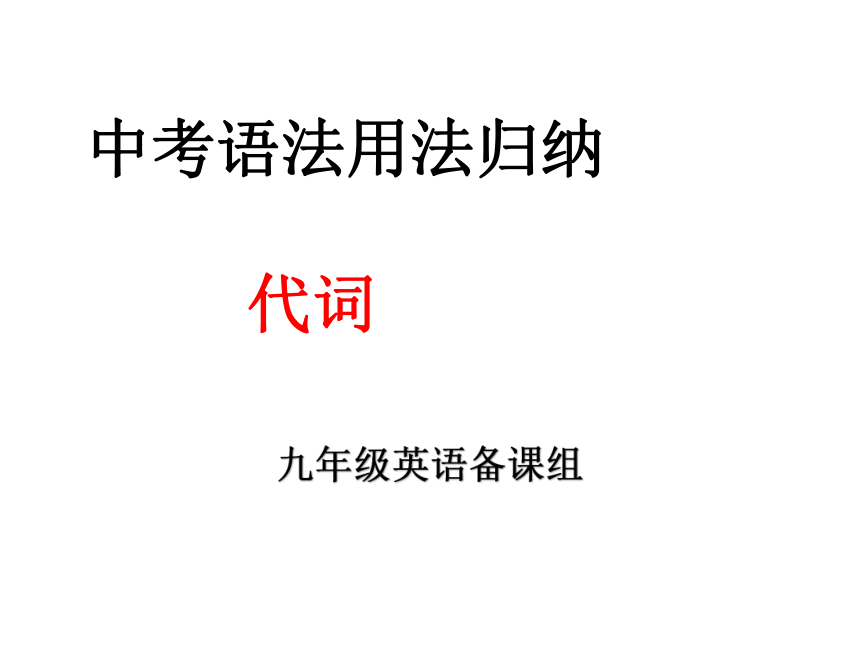 | |
| 格式 | zip | ||
| 文件大小 | 155.7KB | ||
| 资源类型 | 教案 | ||
| 版本资源 | 人教新目标(Go for it)版 | ||
| 科目 | 英语 | ||
| 更新时间 | 2022-07-27 22:45:00 | ||
图片预览

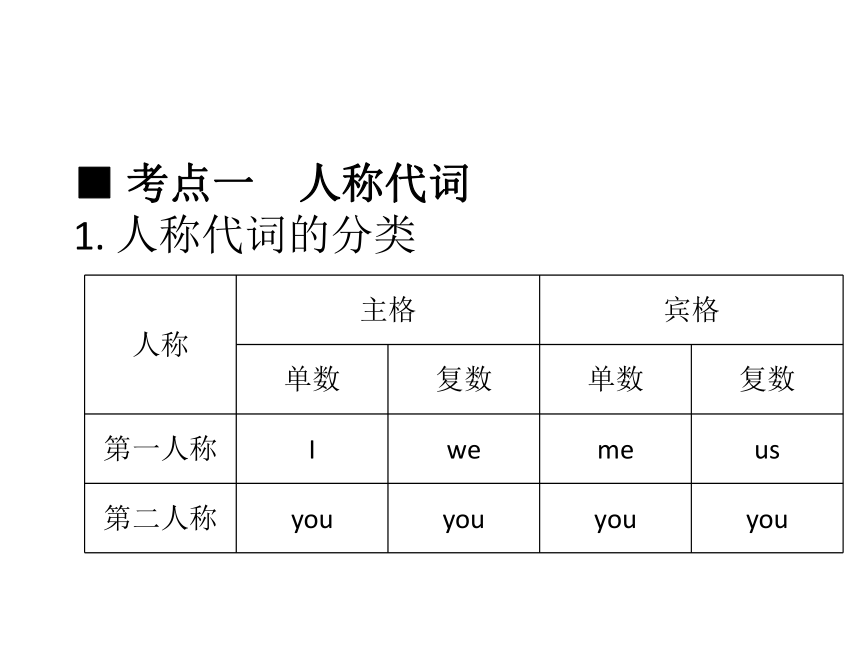

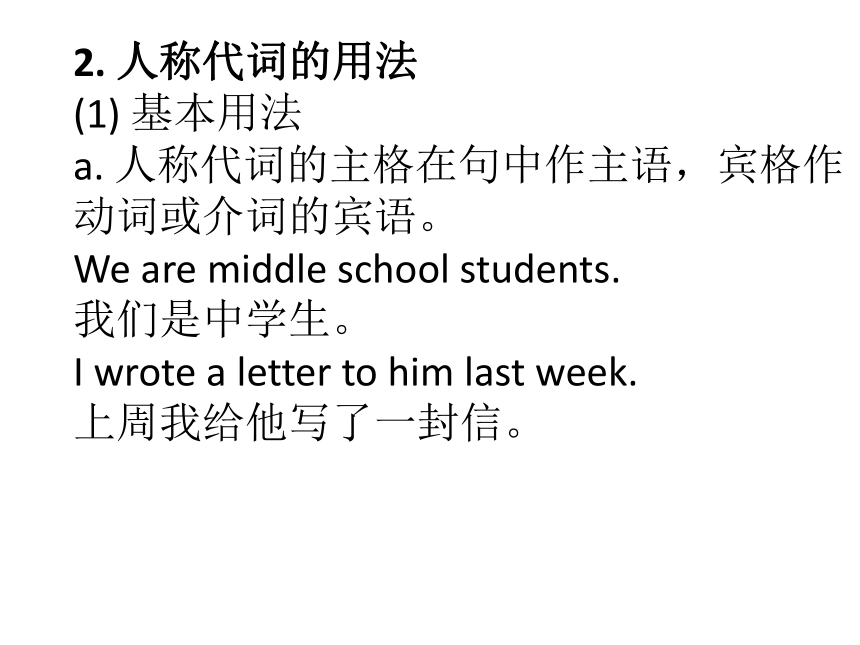

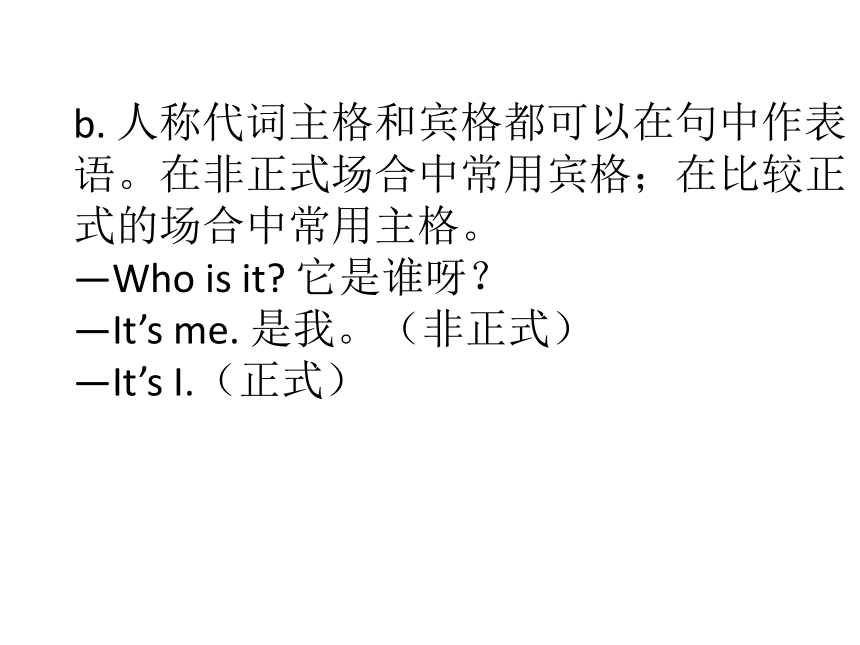

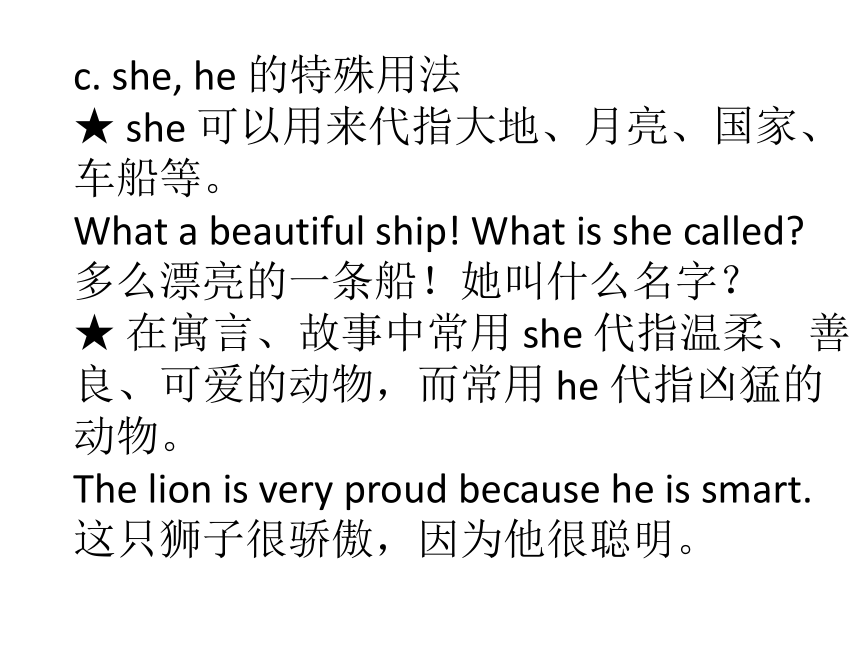
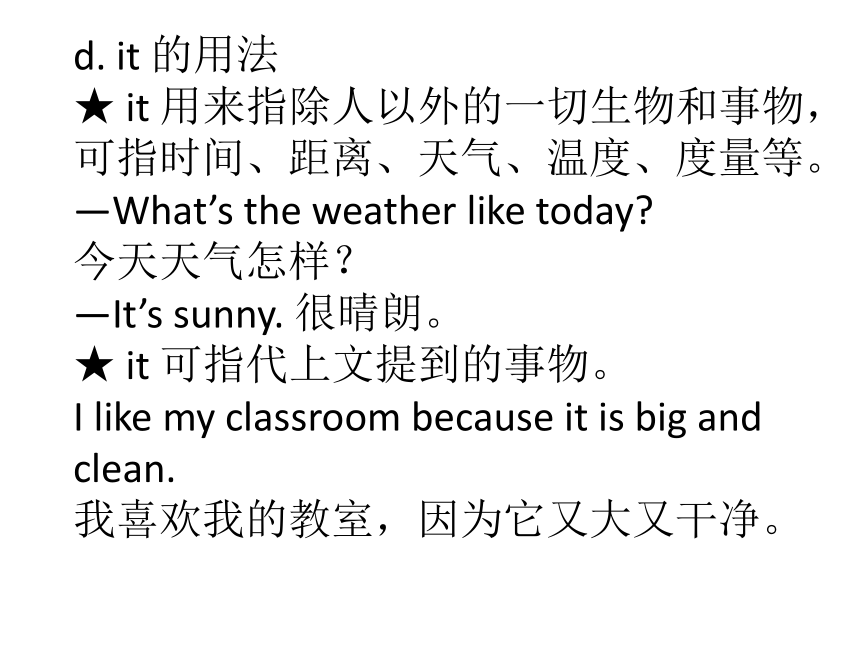
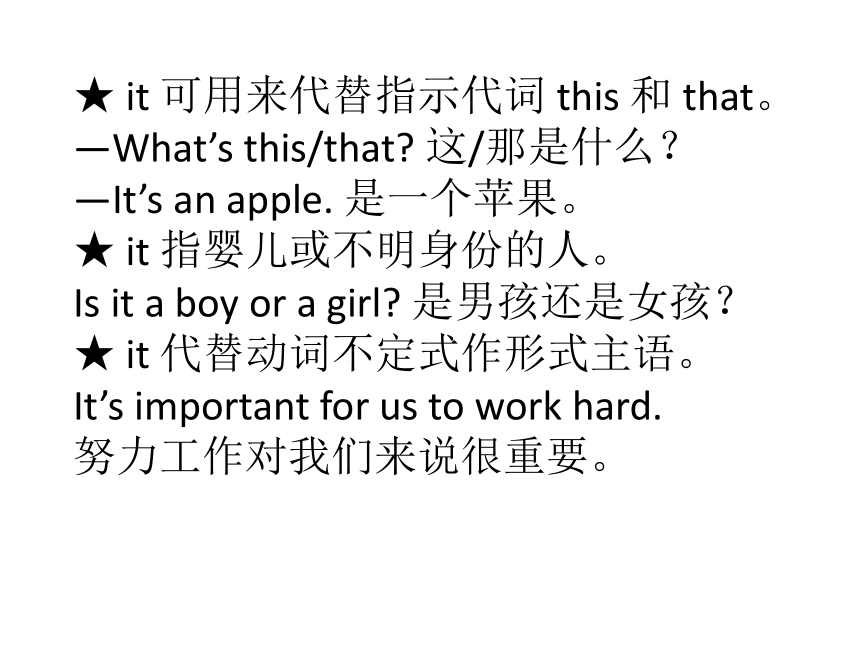
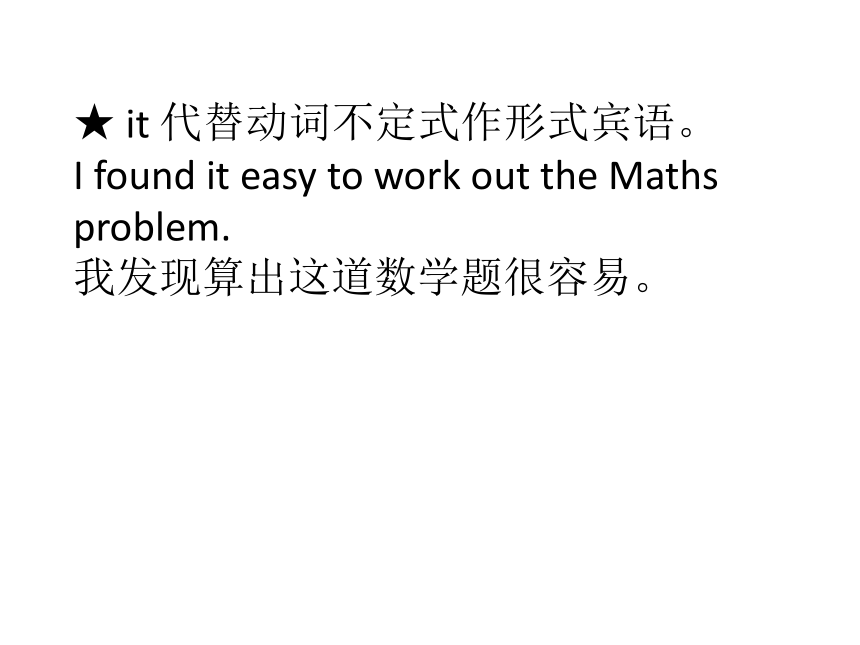
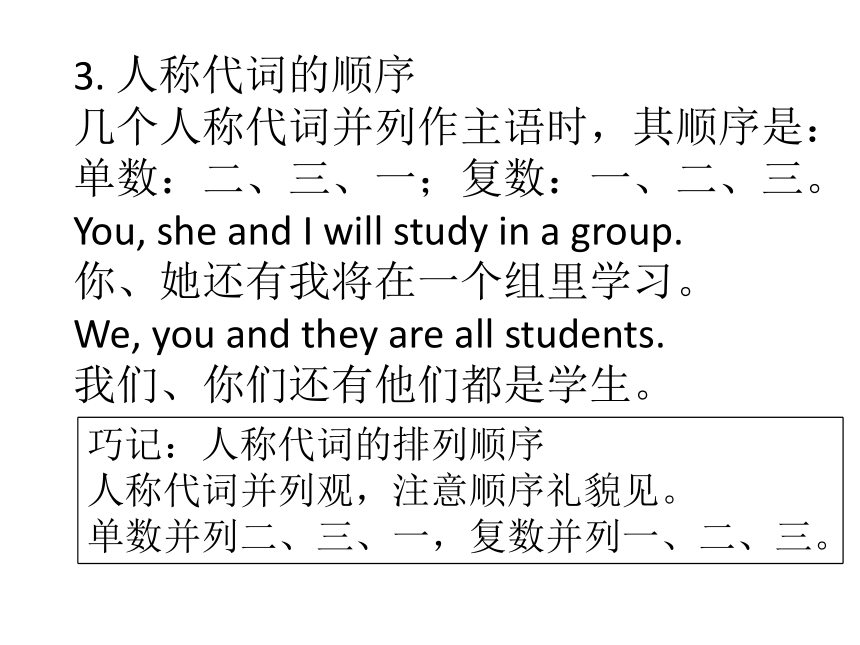
文档简介
(共64张PPT)
中考语法用法归纳
代词
九年级英语备课组
■ 考点一 人称代词
1. 人称代词的分类
人称 主格 宾格
单数 复数 单数 复数
第一人称 I we me us
第二人称 you you you you
1
第三人称 he they him them
she her
it it
2. 人称代词的用法
(1) 基本用法
a. 人称代词的主格在句中作主语,宾格作动词或介词的宾语。
We are middle school students.
我们是中学生。
I wrote a letter to him last week.
上周我给他写了一封信。
注意:
代词宾格作“动词 + 副词”短语的宾语时,需把代词宾格置于动词和副词之间。如果代词宾格作“动词 + 介词”短语的宾语,就要置于介词之后。
Here is your coat. Put it on, please.
这是你的大衣,请把它穿上。
I have to look after her at home today.
我今天必须在家照顾她。
b. 人称代词主格和宾格都可以在句中作表语。在非正式场合中常用宾格;在比较正式的场合中常用主格。
—Who is it 它是谁呀?
—It’s me. 是我。(非正式)
—It’s I.(正式)
(2) 特殊用法
a. 人称代词单独使用或用于简略回答时,通常用宾格。
—Who is going to try 谁来试一下?
—Me. 我。
b. 人称代词用于 as 和 than 之后,如果 as 和 than 作介词,常用宾格;如果 as 和 than 作连词,常用主格。
I’m taller than him. 我比他高。
She is as thin as I am. 她和我一样苗条。
c. she, he 的特殊用法
★ she 可以用来代指大地、月亮、国家、车船等。
What a beautiful ship! What is she called
多么漂亮的一条船!她叫什么名字?
★ 在寓言、故事中常用 she 代指温柔、善良、可爱的动物,而常用 he 代指凶猛的动物。
The lion is very proud because he is smart.
这只狮子很骄傲,因为他很聪明。
d. it 的用法
★ it 用来指除人以外的一切生物和事物,可指时间、距离、天气、温度、度量等。
—What’s the weather like today
今天天气怎样?
—It’s sunny. 很晴朗。
★ it 可指代上文提到的事物。
I like my classroom because it is big and clean.
我喜欢我的教室,因为它又大又干净。
★ it 可用来代替指示代词 this 和 that。
—What’s this/that 这/那是什么?
—It’s an apple. 是一个苹果。
★ it 指婴儿或不明身份的人。
Is it a boy or a girl 是男孩还是女孩?
★ it 代替动词不定式作形式主语。
It’s important for us to work hard.
努力工作对我们来说很重要。
★ it 代替动词不定式作形式宾语。
I found it easy to work out the Maths problem.
我发现算出这道数学题很容易。
3. 人称代词的顺序
几个人称代词并列作主语时,其顺序是:单数:二、三、一;复数:一、二、三。
You, she and I will study in a group.
你、她还有我将在一个组里学习。
We, you and they are all students.
我们、你们还有他们都是学生。
巧记:人称代词的排列顺序
人称代词并列观,注意顺序礼貌见。
单数并列二、三、一,复数并列一、二、三。
对点集训
根据括号内的汉语提示完成句子。
1. _____ (他) knows a lot about Chinese history.
2. To tell you the truth, I don’t like _____ (她).
3. I lost my book. Now I am looking for _____ (它).
4. Do _____ (你) want to have a try
5. ______ (我们) should work hard.
6. The box is too heavy. Can you help _____ (我)
He
her
it
you
We
me
■ 考点二 物主代词
1. 物主代词的分类
人称 形容词性物主代词 名词性物主代词
单数 复数 单数 复数
第一人称 my our mine ours
第二人称 your your yours yours
第三人称 his their his theirs
her
hers
its
its
巧记:
物主代词分两家,形、名词性各一霸。
his,its无变化,my,mine牢记它。
其余变化规律化,名词性后加-s。
2. 物主代词的用法
(1) 形容词性物主代词放在名词前作定语。
That is our classroom. 那是我们的教室。
注意:
在某些固定短语中,形容词性物主代词要随人称而变化。如:do/try one’s best, change one’s mind, do one’s homework, on one’s way to, save one’s life 等。
(2) 名词性物主代词相当于“形容词性物主代词 + 名词”,可作主语、表语或宾语。
This is your rubber. Mine (= My rubber) is in my pencil case.
这是你的橡皮。我的在我的铅笔盒里。
(3) 用于双重所有格中,即“a/an + 名词 + of + 名词性物主代词”。
He is a friend of mine. 他是我的一个朋友。
巧记:物主代词的用法
物主代词两类型,形容词性、名词性。
形容词性作定语,后面定把名词用。
名词性,独立用,主宾表语它都充。
对点集训
用所给单词的适当形式填空。
1. ________ (you) dress is very beautiful.
2. The girl in red is ________ (she) elder sister.
3. I have a dog. ________ (it) name is Strong.
4. That’s not my dictionary. ________ (my) is on the desk.
5. My computer is cheaper than ________ (he).
6. The gloves are ________ (their).
Your
her
Its
Mine
his
theirs
■ 考点三 反身代词
1. 反身代词的单复数形式
人称 单数 复数
第一人称 myself ourselves
第二人称 yourself yourselves
第三人称 himself, herself, itself themselves
数
2. 反身代词的用法
(1) 作宾语,位于及物动词或介词之后。
The boy teaches himself English.
这个男孩儿自学英语。
Look at yourself in the mirror.
对着镜子照照自己。
(2) 作主语或宾语的同位语,用以加强语气,可以放在主语之后或句尾。
John himself did the work. = John did the work himself.
约翰亲自做了这项工作。
(3) 作表语,表示身体“正常”。
She is not quite herself today.
她今天不是很舒服。
注意:
反身代词不可作定语,常用“one’s own”表示“某人自己的”。
This is my own car. 这是我自己的小汽车。
3. 含有反身代词的一些固定搭配
teach oneself 自学
learn ... by oneself 自学
enjoy oneself 过得愉快;玩得开心
devote oneself to 致力于;献身于
come to oneself 苏醒
say to oneself 心里想;自言自语
help oneself to 随便吃……
by oneself 亲自;独自
for oneself 为自己;独自的
of oneself 自动的;自发的
dress oneself 自己穿衣服
hurt oneself 受伤;伤害自己
对点集训
用适当的反身代词填空。
1. Please help _________ to some fruit, children.
2. They enjoyed _________ at the party last night.
3. No one helped him. He did it by ________.
4. Don’t worry. The box is not heavy. I can manage it ________.
yourselves
themselves
himself
myself
5. She is selfish (自私的). She only cares about ________.
6. Tom, if you are not careful, you will hurt ________.
herself
yourself
■ 考点四 指示代词
1. 指示代词的形式
位置 单数 复数
指近处 this these
指远处 that those
2. 指示代词的用法
(1) 作主语、宾语或表语。
This is a chair.(作主语)
这是一把椅子。
I have read that in a newspaper.(作宾语)
我已经在某份报纸上读过那个了。
What I want is this.(作表语)
我所想要的就是这个。
(2) this 可以用来介绍某人。
Hello, Tim. This is Jack. 你好,蒂姆。这是杰克。
(3) 在电话用语中,用 this (我) 介绍自己,用 that (你) 询问对方。
Hello! This is Bob (speaking). Who’s that
你好!我是鲍勃。你是哪位?
(4) that 和 those 可以用在比较结构中,以避免重复。that 代替前面提到的单数名词或不可数名词;those 代替前面提到的复数名词。注意,this 和 these 不能用来代替前面提到的事物。
The population of China is larger than that of Russia.
中国的人口比俄罗斯的人口多。
拓展:
在疑问句的回答中,用 it 代替 this 或 that;用 they 代替 these 或 those。
—What’s this 这是什么?
—It’s a toy plane. 这是一个玩具飞机。
—Are these your flowers 这些是你的花吗?
—No, they aren’t. 不,这些不是。
对点集训
根据汉语意思完成下列句子。
1. 嗨,鲍勃。这位是杰克。
Hi, Bob. ____________ is Jack.
2. 那些不是我们的书。
____________ are not our books.
3. 我不喜欢那个人。
I don’t like ____________ man.
4. 这些礼物都是给你的。
____________ gifts are all for you.
This
Those
that
These
5. 这个单词是什么意思?
What does ____________ word mean
6. 乡村的空气比城市的空气清新。
The air in the country is cleaner than __________ in the city.
this
that
■ 考点五 疑问代词
1. 常见的疑问代词及其基本用法
疑问代词 基本用法 例句
who 作主语、表语或宾语 (作宾语时,不能位于介词后面) Who are you waiting for 你正在等谁?
whom who的宾格形式,作宾语 With whom did you go 你和谁一起去的?
whose who的所有格形式,作主语、表语、宾语或定语 Whose book is it 这是谁的书?
what 作主语、表语、宾语或定语 What is he doing 他正在做什么?
which 作主语、表语、宾语或定语 Which one is bigger 哪一个更大?
2. 疑问代词 who, whom 和 whose 的用法
(1) who 意为“谁”,在句中可以作主语、表语或宾语。
—Who is she 她是谁?
—She is my mother. 她是我妈妈。
(2) whom 意为“谁”,在句中只能作宾语。作动词的宾语时,可以与 who 互换;但作介词的宾语且位于介词之后时,只能用 whom。
Whom did they invite
他们邀请谁了?
With whom did you celebrate your birthday
你和谁一起庆祝了你的生日?
(3) whose 意为“谁的”,在句中可以作主语、表语、宾语或定语。
—Whose socks are these 这些是谁的袜子?
—They are mine. 这些是我的。
3. 疑问代词 what 和 which 的用法
what 意为“什么”,which 意为“哪一个”,它们都可以单独使用,也可以放在名词之前。在句中作主语、宾语、表语或定语。
What are you doing 你在干什么?
Which animals do you like better, lions or pandas
你更喜欢哪种动物,狮子还是熊猫?
对点集训
用适当的疑问代词填空。
1. __________ do you prefer, this one or that one
2. We’ve lost all our money. __________ should we do
3. __________ wallet is this Is it yours, Jack
4. —__________ are you waiting for
—Mary.
5. —__________ is the girl over there
—She’s my sister.
Which
What
Whose
Whom/Who
Who
6. —________ are your parents
—They are teachers.
What
■ 考点六 不定代词
不指明代替任何特定名词的代词叫作不定代词,在句中可以作主语、宾语、表语、同位语等。不定代词分为普通不定代词和复合不定代词。
1. 普通不定代词
主要有:some, any, both, all, another, other, each, either, neither, none, one(s), a few, few, a little, little, many, much 等。
2. 几种常见的普通不定代词的用法辨析
(1) one与ones
单词 用法 例句
one 用来代替上文出现过的同类单数名词,以免重复,可以指人,也可以指物。其前可以用 the, this, that, which 等词修饰 —Are there any science labs
有一些科学实验室吗?
—Yes, there is one behind the library.
有,在图书馆的后面有一个。
ones 用来代替同类复数名词。其前可以用 the, these, those, which 等词修饰 The only jokes I tell are the ones that I hear from you. 我所讲的笑话都是从你那儿听到的。
注意:it, one 和 that 都可以用来代替上文提到的单数人或物,但 it 指同一事物;one 指同名异物,并且前面可以有修饰词,只代替可数名词单数;that 指同一类,并非同一个,常用于代替不可数名词。
(2) some 与 any
相同点 单词 用法 例句
修饰可数 或不可数 名词 some 一般用于肯定句中 There are some boys playing football.
有一些男孩正在踢足球。
在征求意见的疑问句中或希望得到肯定回答的疑问句中,常用 some Would you like some water 你想喝些水吗?
Do we need to buy some meat
我们需要买一些肉吗?
相同点 单词 用法 例句
修饰可数 或不可数 名词 any 一般用于否定句、疑问句或条件状语从句中 There isn’t any meat in the fridge.
冰箱里没有肉了。
注意:
1. 在否定句中 not any 的意义相当于 no。
There isn’t any (= is no) water in the bottle. 这个瓶子里一点儿水都没有。
2. some 用于可数名词单数前,表示“某个”。
Some careless man has taken my umbrella. 某个粗心大意的人拿走了我的伞。
(3) both, all, neither, none, either 与 any
之一 都 都不
适用范围 两者 either both neither
三者或以上 any all none
固定短语 both ... and ...(连接两个主语,谓语动词用复数) either ... or ...(连接两个主语,谓语动词遵循“就近原则”) neither ... nor ...(连接两个主语,谓语动词遵循“就近原则”)
例句 All children like toys. 所有的孩子都喜欢玩具。
None of us like comedies. 我们中没有人喜欢喜剧片。
Here is only one ticket. Either of you can watch the football match.
这里只有一张票。你们两个人中只有一个人能观看足球赛。
注意:
1. both 和 all 作同位语时,放在 be 动词、情态动词、助动词之后,实义动词之前。
We both come from England. 我们俩都来自英国。
They were all happy. 他们都很高兴。
2. both 和 all 都可以和 of 连用。of 后是名词时,of 可以省略;of 后是代词宾格时,of 不能省略。
Both of us want to go. 我们两个都想去。
Are all of the students (= all the students) here today 今天所有的学生都到了吗?
3. both 和 all 与 not 连用时表示部分否定,意为“并非……都……”。
Both my parents are not teachers. 我的父母并非都是老师。
Not all the students agree with you. 并非所有的学生都同意你的观点。
(4) little, a little, few 与 a few
很少;几乎没有(表否定) 几个;一点儿(肯定)
修饰可数名词 few a few
修饰不可数名词 little a little
例句 Don’t worry! There is a little time left. 别着急!还有一点儿时间。 He has a few friends here, but he has few good friends. 在这里他有几个朋友,但是几乎没有好朋友。
注意:
only,quite 和 not 可以与 a few 和 a little 连用,但不能与 few 和 little 连用。only a few 意为“只有几个”,only a little 意为“很少”;quite a few 意为“相当多”,quite a little 意为“相当多”;not a few 意为“相当多”,not a little 意为“许多”。
(5) other(s), the other(s), another
概念 泛指剩下的一部分(不用the) 特指剩下的全体(要用the)
成分 作主语 / 宾语 作定语(其后加名词) 作主语 / 宾语 作定语(其后加名词)
数 单数 another another book the other the other book
复数 others other books the others the other books
注意:
another 后可接“基数词 + 名词”,表示“又、再”,相当于“基数词 + more + 名词”。
They suggested we stay in Shanghai for another two weeks (= two more weeks).
他们建议我们在上海再待两个星期。
(6) many 与 much
单词 含义 用法
many 许多 修饰可数名词 many 和 much 可以与副词 so,too,as,how 连用
There are too many people in the square. 广场上的人太多了。
How much did your coat cost 你的大衣多少钱?
much 修饰不可数名词
注意:
many 后可以接不定冠词 a 或 an 再加单数可数名词,谓语动词用单数,但意义和 many 加复数名词相同。
Many a student has failed. = Many students have failed. 许多学生失败了。
3. 复合不定代词
- one - thing - body
some - someone something somebody
any - anyone anything anybody
every - everyone everything everybody
no - no one nothing nobody
(1) 一般情况下,由 some 构成的复合不定代词用在肯定句中;由 any 构成的复合不定代词用在疑问句和否定句中;由 no 构成的复合不定代词表示否定意义。
I have something to tell you. 我有事要告诉你。
I can’t see anything. 我什么也看不见。
There’s nothing I can do. 我什么也做不了。
(2) 形容词或else修饰不定代词时,通常位于不定代词之后。
Do you want anything else
你还想要其他的东西吗?
(3) 由 any 构成的复合不定代词与 not 连用,相当于由 no 构成的复合不定代词。
There is not anything (= nothing) in that box.
那个盒子里没有什么东西。
(4) no one 可以用于回答 who 引导的疑问句,不能回答 how many 引导的疑问句。
—Who knows the answer to the question
谁知道这个问题的答案?
—No one. 没有人(知道)。
(5) 由 every 构成的复合不定代词与 not 连用,表示部分否定。
Not everybody likes watching TV.
并非人人都喜欢看电视。
(6) 由 one 和 body 构成的复合不定代词之后可以加 -’s 构成所有格。
He just found someone’s wallet.
他刚刚发现了别人的钱包。
注意:
由 one 和 body 构成的复合不定代词的意义和用法相同,可以互换。
对点集训
选词填空。
1. Would you like ____________ coffee (some/any)
2. There are a ____________ mistakes in your exercises. (few/little)
3. There are trees on ____________ side of the street. (either/both)
4. Here are two books. You can only take _________ of them. (one/it)
some
few
either
one
5. These two dresses are not my style. Please show me ____________ one. (another/other)
6. The Maths problem is too difficult. ____________ can work it out. (Everybody/Nobody)
another
Nobody
中考语法用法归纳
代词
九年级英语备课组
■ 考点一 人称代词
1. 人称代词的分类
人称 主格 宾格
单数 复数 单数 复数
第一人称 I we me us
第二人称 you you you you
1
第三人称 he they him them
she her
it it
2. 人称代词的用法
(1) 基本用法
a. 人称代词的主格在句中作主语,宾格作动词或介词的宾语。
We are middle school students.
我们是中学生。
I wrote a letter to him last week.
上周我给他写了一封信。
注意:
代词宾格作“动词 + 副词”短语的宾语时,需把代词宾格置于动词和副词之间。如果代词宾格作“动词 + 介词”短语的宾语,就要置于介词之后。
Here is your coat. Put it on, please.
这是你的大衣,请把它穿上。
I have to look after her at home today.
我今天必须在家照顾她。
b. 人称代词主格和宾格都可以在句中作表语。在非正式场合中常用宾格;在比较正式的场合中常用主格。
—Who is it 它是谁呀?
—It’s me. 是我。(非正式)
—It’s I.(正式)
(2) 特殊用法
a. 人称代词单独使用或用于简略回答时,通常用宾格。
—Who is going to try 谁来试一下?
—Me. 我。
b. 人称代词用于 as 和 than 之后,如果 as 和 than 作介词,常用宾格;如果 as 和 than 作连词,常用主格。
I’m taller than him. 我比他高。
She is as thin as I am. 她和我一样苗条。
c. she, he 的特殊用法
★ she 可以用来代指大地、月亮、国家、车船等。
What a beautiful ship! What is she called
多么漂亮的一条船!她叫什么名字?
★ 在寓言、故事中常用 she 代指温柔、善良、可爱的动物,而常用 he 代指凶猛的动物。
The lion is very proud because he is smart.
这只狮子很骄傲,因为他很聪明。
d. it 的用法
★ it 用来指除人以外的一切生物和事物,可指时间、距离、天气、温度、度量等。
—What’s the weather like today
今天天气怎样?
—It’s sunny. 很晴朗。
★ it 可指代上文提到的事物。
I like my classroom because it is big and clean.
我喜欢我的教室,因为它又大又干净。
★ it 可用来代替指示代词 this 和 that。
—What’s this/that 这/那是什么?
—It’s an apple. 是一个苹果。
★ it 指婴儿或不明身份的人。
Is it a boy or a girl 是男孩还是女孩?
★ it 代替动词不定式作形式主语。
It’s important for us to work hard.
努力工作对我们来说很重要。
★ it 代替动词不定式作形式宾语。
I found it easy to work out the Maths problem.
我发现算出这道数学题很容易。
3. 人称代词的顺序
几个人称代词并列作主语时,其顺序是:单数:二、三、一;复数:一、二、三。
You, she and I will study in a group.
你、她还有我将在一个组里学习。
We, you and they are all students.
我们、你们还有他们都是学生。
巧记:人称代词的排列顺序
人称代词并列观,注意顺序礼貌见。
单数并列二、三、一,复数并列一、二、三。
对点集训
根据括号内的汉语提示完成句子。
1. _____ (他) knows a lot about Chinese history.
2. To tell you the truth, I don’t like _____ (她).
3. I lost my book. Now I am looking for _____ (它).
4. Do _____ (你) want to have a try
5. ______ (我们) should work hard.
6. The box is too heavy. Can you help _____ (我)
He
her
it
you
We
me
■ 考点二 物主代词
1. 物主代词的分类
人称 形容词性物主代词 名词性物主代词
单数 复数 单数 复数
第一人称 my our mine ours
第二人称 your your yours yours
第三人称 his their his theirs
her
hers
its
its
巧记:
物主代词分两家,形、名词性各一霸。
his,its无变化,my,mine牢记它。
其余变化规律化,名词性后加-s。
2. 物主代词的用法
(1) 形容词性物主代词放在名词前作定语。
That is our classroom. 那是我们的教室。
注意:
在某些固定短语中,形容词性物主代词要随人称而变化。如:do/try one’s best, change one’s mind, do one’s homework, on one’s way to, save one’s life 等。
(2) 名词性物主代词相当于“形容词性物主代词 + 名词”,可作主语、表语或宾语。
This is your rubber. Mine (= My rubber) is in my pencil case.
这是你的橡皮。我的在我的铅笔盒里。
(3) 用于双重所有格中,即“a/an + 名词 + of + 名词性物主代词”。
He is a friend of mine. 他是我的一个朋友。
巧记:物主代词的用法
物主代词两类型,形容词性、名词性。
形容词性作定语,后面定把名词用。
名词性,独立用,主宾表语它都充。
对点集训
用所给单词的适当形式填空。
1. ________ (you) dress is very beautiful.
2. The girl in red is ________ (she) elder sister.
3. I have a dog. ________ (it) name is Strong.
4. That’s not my dictionary. ________ (my) is on the desk.
5. My computer is cheaper than ________ (he).
6. The gloves are ________ (their).
Your
her
Its
Mine
his
theirs
■ 考点三 反身代词
1. 反身代词的单复数形式
人称 单数 复数
第一人称 myself ourselves
第二人称 yourself yourselves
第三人称 himself, herself, itself themselves
数
2. 反身代词的用法
(1) 作宾语,位于及物动词或介词之后。
The boy teaches himself English.
这个男孩儿自学英语。
Look at yourself in the mirror.
对着镜子照照自己。
(2) 作主语或宾语的同位语,用以加强语气,可以放在主语之后或句尾。
John himself did the work. = John did the work himself.
约翰亲自做了这项工作。
(3) 作表语,表示身体“正常”。
She is not quite herself today.
她今天不是很舒服。
注意:
反身代词不可作定语,常用“one’s own”表示“某人自己的”。
This is my own car. 这是我自己的小汽车。
3. 含有反身代词的一些固定搭配
teach oneself 自学
learn ... by oneself 自学
enjoy oneself 过得愉快;玩得开心
devote oneself to 致力于;献身于
come to oneself 苏醒
say to oneself 心里想;自言自语
help oneself to 随便吃……
by oneself 亲自;独自
for oneself 为自己;独自的
of oneself 自动的;自发的
dress oneself 自己穿衣服
hurt oneself 受伤;伤害自己
对点集训
用适当的反身代词填空。
1. Please help _________ to some fruit, children.
2. They enjoyed _________ at the party last night.
3. No one helped him. He did it by ________.
4. Don’t worry. The box is not heavy. I can manage it ________.
yourselves
themselves
himself
myself
5. She is selfish (自私的). She only cares about ________.
6. Tom, if you are not careful, you will hurt ________.
herself
yourself
■ 考点四 指示代词
1. 指示代词的形式
位置 单数 复数
指近处 this these
指远处 that those
2. 指示代词的用法
(1) 作主语、宾语或表语。
This is a chair.(作主语)
这是一把椅子。
I have read that in a newspaper.(作宾语)
我已经在某份报纸上读过那个了。
What I want is this.(作表语)
我所想要的就是这个。
(2) this 可以用来介绍某人。
Hello, Tim. This is Jack. 你好,蒂姆。这是杰克。
(3) 在电话用语中,用 this (我) 介绍自己,用 that (你) 询问对方。
Hello! This is Bob (speaking). Who’s that
你好!我是鲍勃。你是哪位?
(4) that 和 those 可以用在比较结构中,以避免重复。that 代替前面提到的单数名词或不可数名词;those 代替前面提到的复数名词。注意,this 和 these 不能用来代替前面提到的事物。
The population of China is larger than that of Russia.
中国的人口比俄罗斯的人口多。
拓展:
在疑问句的回答中,用 it 代替 this 或 that;用 they 代替 these 或 those。
—What’s this 这是什么?
—It’s a toy plane. 这是一个玩具飞机。
—Are these your flowers 这些是你的花吗?
—No, they aren’t. 不,这些不是。
对点集训
根据汉语意思完成下列句子。
1. 嗨,鲍勃。这位是杰克。
Hi, Bob. ____________ is Jack.
2. 那些不是我们的书。
____________ are not our books.
3. 我不喜欢那个人。
I don’t like ____________ man.
4. 这些礼物都是给你的。
____________ gifts are all for you.
This
Those
that
These
5. 这个单词是什么意思?
What does ____________ word mean
6. 乡村的空气比城市的空气清新。
The air in the country is cleaner than __________ in the city.
this
that
■ 考点五 疑问代词
1. 常见的疑问代词及其基本用法
疑问代词 基本用法 例句
who 作主语、表语或宾语 (作宾语时,不能位于介词后面) Who are you waiting for 你正在等谁?
whom who的宾格形式,作宾语 With whom did you go 你和谁一起去的?
whose who的所有格形式,作主语、表语、宾语或定语 Whose book is it 这是谁的书?
what 作主语、表语、宾语或定语 What is he doing 他正在做什么?
which 作主语、表语、宾语或定语 Which one is bigger 哪一个更大?
2. 疑问代词 who, whom 和 whose 的用法
(1) who 意为“谁”,在句中可以作主语、表语或宾语。
—Who is she 她是谁?
—She is my mother. 她是我妈妈。
(2) whom 意为“谁”,在句中只能作宾语。作动词的宾语时,可以与 who 互换;但作介词的宾语且位于介词之后时,只能用 whom。
Whom did they invite
他们邀请谁了?
With whom did you celebrate your birthday
你和谁一起庆祝了你的生日?
(3) whose 意为“谁的”,在句中可以作主语、表语、宾语或定语。
—Whose socks are these 这些是谁的袜子?
—They are mine. 这些是我的。
3. 疑问代词 what 和 which 的用法
what 意为“什么”,which 意为“哪一个”,它们都可以单独使用,也可以放在名词之前。在句中作主语、宾语、表语或定语。
What are you doing 你在干什么?
Which animals do you like better, lions or pandas
你更喜欢哪种动物,狮子还是熊猫?
对点集训
用适当的疑问代词填空。
1. __________ do you prefer, this one or that one
2. We’ve lost all our money. __________ should we do
3. __________ wallet is this Is it yours, Jack
4. —__________ are you waiting for
—Mary.
5. —__________ is the girl over there
—She’s my sister.
Which
What
Whose
Whom/Who
Who
6. —________ are your parents
—They are teachers.
What
■ 考点六 不定代词
不指明代替任何特定名词的代词叫作不定代词,在句中可以作主语、宾语、表语、同位语等。不定代词分为普通不定代词和复合不定代词。
1. 普通不定代词
主要有:some, any, both, all, another, other, each, either, neither, none, one(s), a few, few, a little, little, many, much 等。
2. 几种常见的普通不定代词的用法辨析
(1) one与ones
单词 用法 例句
one 用来代替上文出现过的同类单数名词,以免重复,可以指人,也可以指物。其前可以用 the, this, that, which 等词修饰 —Are there any science labs
有一些科学实验室吗?
—Yes, there is one behind the library.
有,在图书馆的后面有一个。
ones 用来代替同类复数名词。其前可以用 the, these, those, which 等词修饰 The only jokes I tell are the ones that I hear from you. 我所讲的笑话都是从你那儿听到的。
注意:it, one 和 that 都可以用来代替上文提到的单数人或物,但 it 指同一事物;one 指同名异物,并且前面可以有修饰词,只代替可数名词单数;that 指同一类,并非同一个,常用于代替不可数名词。
(2) some 与 any
相同点 单词 用法 例句
修饰可数 或不可数 名词 some 一般用于肯定句中 There are some boys playing football.
有一些男孩正在踢足球。
在征求意见的疑问句中或希望得到肯定回答的疑问句中,常用 some Would you like some water 你想喝些水吗?
Do we need to buy some meat
我们需要买一些肉吗?
相同点 单词 用法 例句
修饰可数 或不可数 名词 any 一般用于否定句、疑问句或条件状语从句中 There isn’t any meat in the fridge.
冰箱里没有肉了。
注意:
1. 在否定句中 not any 的意义相当于 no。
There isn’t any (= is no) water in the bottle. 这个瓶子里一点儿水都没有。
2. some 用于可数名词单数前,表示“某个”。
Some careless man has taken my umbrella. 某个粗心大意的人拿走了我的伞。
(3) both, all, neither, none, either 与 any
之一 都 都不
适用范围 两者 either both neither
三者或以上 any all none
固定短语 both ... and ...(连接两个主语,谓语动词用复数) either ... or ...(连接两个主语,谓语动词遵循“就近原则”) neither ... nor ...(连接两个主语,谓语动词遵循“就近原则”)
例句 All children like toys. 所有的孩子都喜欢玩具。
None of us like comedies. 我们中没有人喜欢喜剧片。
Here is only one ticket. Either of you can watch the football match.
这里只有一张票。你们两个人中只有一个人能观看足球赛。
注意:
1. both 和 all 作同位语时,放在 be 动词、情态动词、助动词之后,实义动词之前。
We both come from England. 我们俩都来自英国。
They were all happy. 他们都很高兴。
2. both 和 all 都可以和 of 连用。of 后是名词时,of 可以省略;of 后是代词宾格时,of 不能省略。
Both of us want to go. 我们两个都想去。
Are all of the students (= all the students) here today 今天所有的学生都到了吗?
3. both 和 all 与 not 连用时表示部分否定,意为“并非……都……”。
Both my parents are not teachers. 我的父母并非都是老师。
Not all the students agree with you. 并非所有的学生都同意你的观点。
(4) little, a little, few 与 a few
很少;几乎没有(表否定) 几个;一点儿(肯定)
修饰可数名词 few a few
修饰不可数名词 little a little
例句 Don’t worry! There is a little time left. 别着急!还有一点儿时间。 He has a few friends here, but he has few good friends. 在这里他有几个朋友,但是几乎没有好朋友。
注意:
only,quite 和 not 可以与 a few 和 a little 连用,但不能与 few 和 little 连用。only a few 意为“只有几个”,only a little 意为“很少”;quite a few 意为“相当多”,quite a little 意为“相当多”;not a few 意为“相当多”,not a little 意为“许多”。
(5) other(s), the other(s), another
概念 泛指剩下的一部分(不用the) 特指剩下的全体(要用the)
成分 作主语 / 宾语 作定语(其后加名词) 作主语 / 宾语 作定语(其后加名词)
数 单数 another another book the other the other book
复数 others other books the others the other books
注意:
another 后可接“基数词 + 名词”,表示“又、再”,相当于“基数词 + more + 名词”。
They suggested we stay in Shanghai for another two weeks (= two more weeks).
他们建议我们在上海再待两个星期。
(6) many 与 much
单词 含义 用法
many 许多 修饰可数名词 many 和 much 可以与副词 so,too,as,how 连用
There are too many people in the square. 广场上的人太多了。
How much did your coat cost 你的大衣多少钱?
much 修饰不可数名词
注意:
many 后可以接不定冠词 a 或 an 再加单数可数名词,谓语动词用单数,但意义和 many 加复数名词相同。
Many a student has failed. = Many students have failed. 许多学生失败了。
3. 复合不定代词
- one - thing - body
some - someone something somebody
any - anyone anything anybody
every - everyone everything everybody
no - no one nothing nobody
(1) 一般情况下,由 some 构成的复合不定代词用在肯定句中;由 any 构成的复合不定代词用在疑问句和否定句中;由 no 构成的复合不定代词表示否定意义。
I have something to tell you. 我有事要告诉你。
I can’t see anything. 我什么也看不见。
There’s nothing I can do. 我什么也做不了。
(2) 形容词或else修饰不定代词时,通常位于不定代词之后。
Do you want anything else
你还想要其他的东西吗?
(3) 由 any 构成的复合不定代词与 not 连用,相当于由 no 构成的复合不定代词。
There is not anything (= nothing) in that box.
那个盒子里没有什么东西。
(4) no one 可以用于回答 who 引导的疑问句,不能回答 how many 引导的疑问句。
—Who knows the answer to the question
谁知道这个问题的答案?
—No one. 没有人(知道)。
(5) 由 every 构成的复合不定代词与 not 连用,表示部分否定。
Not everybody likes watching TV.
并非人人都喜欢看电视。
(6) 由 one 和 body 构成的复合不定代词之后可以加 -’s 构成所有格。
He just found someone’s wallet.
他刚刚发现了别人的钱包。
注意:
由 one 和 body 构成的复合不定代词的意义和用法相同,可以互换。
对点集训
选词填空。
1. Would you like ____________ coffee (some/any)
2. There are a ____________ mistakes in your exercises. (few/little)
3. There are trees on ____________ side of the street. (either/both)
4. Here are two books. You can only take _________ of them. (one/it)
some
few
either
one
5. These two dresses are not my style. Please show me ____________ one. (another/other)
6. The Maths problem is too difficult. ____________ can work it out. (Everybody/Nobody)
another
Nobody
同课章节目录
- 词法
- 名词
- 动词和动词短语
- 动词语态
- 动词时态
- 助动词和情态动词
- 非谓语动词
- 冠词
- 代词
- 数词和量词
- 形容词副词及其比较等级
- 介词和介词短语
- 连词和感叹词
- 构词法
- 相似、相近词比较
- 句法
- 陈述句
- 一般疑问句和否定疑问句
- 特殊疑问句及选择疑问句
- 反意疑问句
- 存在句(There be句型)
- 宾语从句
- 定语从句
- 状语从句
- 主谓一致问题
- 简单句
- 并列句
- 复合句
- 主谓一致
- 主、表语从句
- 名词性从句
- 直接引语和间接引语
- 虚拟语气
- 感叹句
- 强调句
- 倒装句
- 祈使句
- 句子的成分
- 句子的分类
- 题型专区
- 单项选择部分
- 易错题
- 完形填空
- 阅读理解
- 词汇练习
- 听说训练
- 句型转换
- 补全对话
- 短文改错
- 翻译
- 书面表达
- 任务型阅读
- 语法填空
- 其他资料
